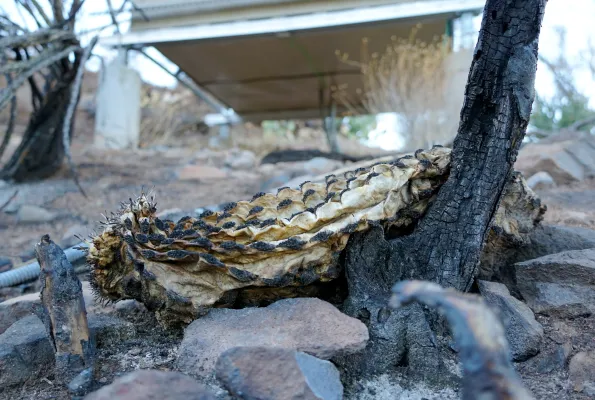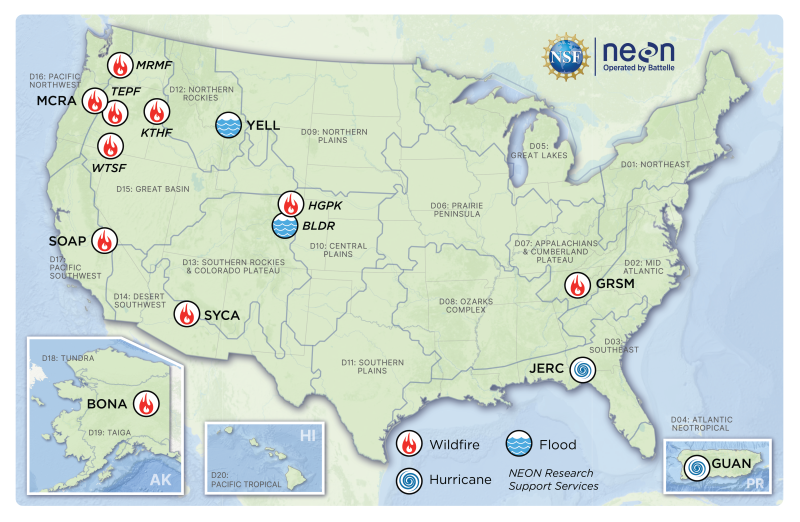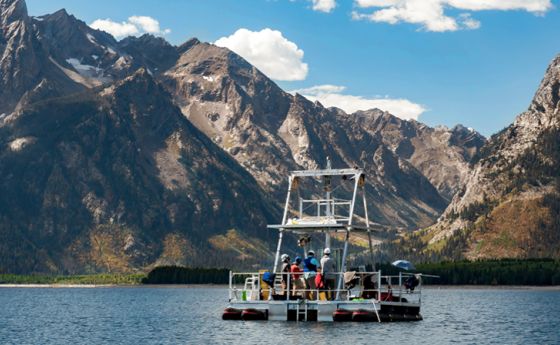
Fire at the field site: What we can learn from disturbances at NSF National Ecological Observatory Network sites
According to the National Interagency Fire Center, from December 2023 to December 2024, there were over 52,000 separate wildfires in the United States. One of those fires, the Sand Stone Fire, damaged areas in Central Arizona just northeast of Phoenix. While, thankfully, the fire did not damage any homes or claim any lives, it did burn portions of the Sycamore Creek site of the NSF National Ecological Observatory Network (NSF NEON). As the damage is remedied, researchers could use the impact and data NSF NEON collects to learn more about how fire interacts with the environment.
Ecology of fire in the Sonoran Desert
Sycamore Creek is an aquatic NEON site in the Tonto National Forest, managed by the U.S. Forest Service (USFS). The area, broadly part of the Sonoran Desert, is populated by a mix of native and invasive plant species, with many of the latter brought in by humans. Introduced grasses can help feed fire, further impacting native species — including the well-known Saguaro cactus — many of which are not adapted to survive frequent intense fires.
As fires become more frequent, they are also becoming larger, according to Lata.
"Fires are getting bigger because of the contiguous fuel load from grasses, and it's mostly introduced grasses, red brome. But they've been here for so long, we can't get rid of them, and so that IS the system now," she said.
Studying disturbance in Sycamore Creek
The area in and around Sycamore Creek has been used to study the impact of environmental disturbances for some time. The work has been funded by NSF investments as well as those of other federal agencies.
In addition to fire, the area faces disturbance from flooding that results from heavy rains during monsoon season, leading to impacts on both the biology and geology of the area. During the dry season, the potential for wildfire is high, and the ecosystem can take decades to recover from large fires. Additionally, the changing landscape and introduction of invasive plant species provide a unique vehicle to study the impacts of ecological change.
Since 1997, the Central Arizona-Phoenix site of the NSF Long Term Ecological Research site, managed by Arizona State University, has engaged in research on the human-environment interactions mediated by urban ecological infrastructure in the Phoenix metro area and the surrounding parts of the Sonoran Desert. USFS conducts research and management activities that support native flora and fauna (especially rare or endangered species), invasive species removal and monitoring, riparian resources protection, mining and grazing permitting, and wilderness areas management.
NEON, through instrumentation, field collections and airborne observations, collects an array of data at Sycamore Creek. This includes information on vegetation composition and the amount of area covered with plants, ecosystem structure, relative humidity, wind, temperature, precipitation, streamflow, aquatic organisms and more. The observatory collects these data at each of its other 81 sites across the country and provides them all openly and free. These standardized data from across ecosystems enable novel research on the impacts of ecological disturbance.
"NEON is discovering processes operating at continental scales that determine ecosystem responses to droughts, floods, hurricanes, wildfire and other large-scale disturbance events," said Andrew Elmore, program director in the NSF Directorate for Biological Sciences, who works on the NEON program. "These disturbances can cause direct or downstream effects on natural resources on which society is dependent and that are costly to remedy, so it is critical that we monitor these things."
Facts about the Sand Stone Fire
|
Impact on NEON and possibilities for research moving forward
The Sand Stone Fire damaged communication and power equipment at Sycamore Creek, but the automatic sensors that collect the data were unaffected. While the sensors continued to collect data, due to the damaged equipment, the facility could not stream data and make it accessible to the community in real time.
Outside of the equipment, the ground and vegetation around the site were badly burnt. Where iconic Saguaro cacti once stood tall, most in the area are now just limp, charred skeletons on blackened ground.
"Just looking at a picture or video, you can see the difference between the site pre-fire and after," said Paula Mabee, NEON chief scientist and observatory director. "That visible difference likely doesn't even begin to show the long-term effects on the ecology of the area. Due to the harsh desert conditions and fragile soil, recovery after a major fire is slow and can take decades."
As with previous impacts on the observatory, the data collected hold the potential to explain fire and fuel dynamics, impacts on natural resources and biodiversity, and more. NEON Airborne Observation Platform (AOP) surveys of the areas provided a foundational baseline to measure the change.
Prior to the Sand Stone Fire, NEON staff had documented nine wildfires, two floods and two hurricanes impacting sites from the Pacific Northwest to Appalachia, Alaska to Puerto Rico. In these cases, the data NEON collected were used by the community to understand spatial burn severity patterns, fuel characteristics, and pre-fire forest structure.
The impact on Sycamore Creek presents similar opportunities for understanding pre-, during and post-fire characteristics of the environment and working to apply them to broader contexts with an eventual goal of mitigating the impact of wildfires on communities and infrastructure.
For example, research using the NEON AOP and satellite data could be used to track carbon release from areas impacted by the fire and compare them to areas that have not been burnt. Similarly, soil sensors and measurements taken by field staff can denote how the area's flora — and the various forms of life it supports — recovers after the fire.
"There is immense scientific potential provided by using the sensors, LiDAR, and field data, but there is also immense educational opportunity," Mabee said. "Training the next generation of scientists to use this type and amount of data to predict disturbance and mitigate its impact is a key component of NEON."
Get to know NSF NEON
|
NEON hosts public Science Seminars on many topics, including using NEON to enable remote sensing in forests, coding tutorials to aid in understanding and making use of LiDAR data, and other avenues for learning about ecology, wildland fire, and environmental data science. The upcoming Feb. 11 seminar will cover insight into satellite-based fire tracking and ecosystem impacts.
The data from the Sycamore Creek site could be used to understand fire in this broader scientific and educational context, but it will also have use in understanding the ecology of the Sonoran Desert and the Southwestern U.S., a key focal area given recent environmental and societal changes in the area.
"I just want to see a lot more people digging into this geographic area to really get more understanding of what these changes mean for the future of the desert," said Lata.





